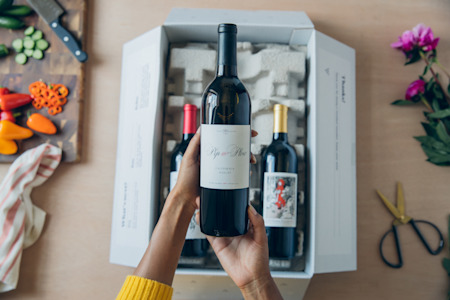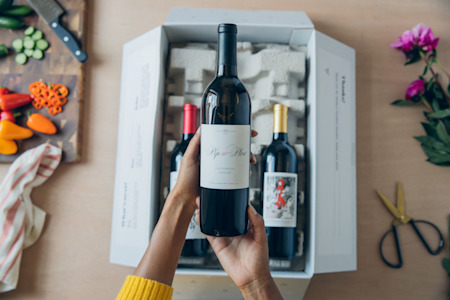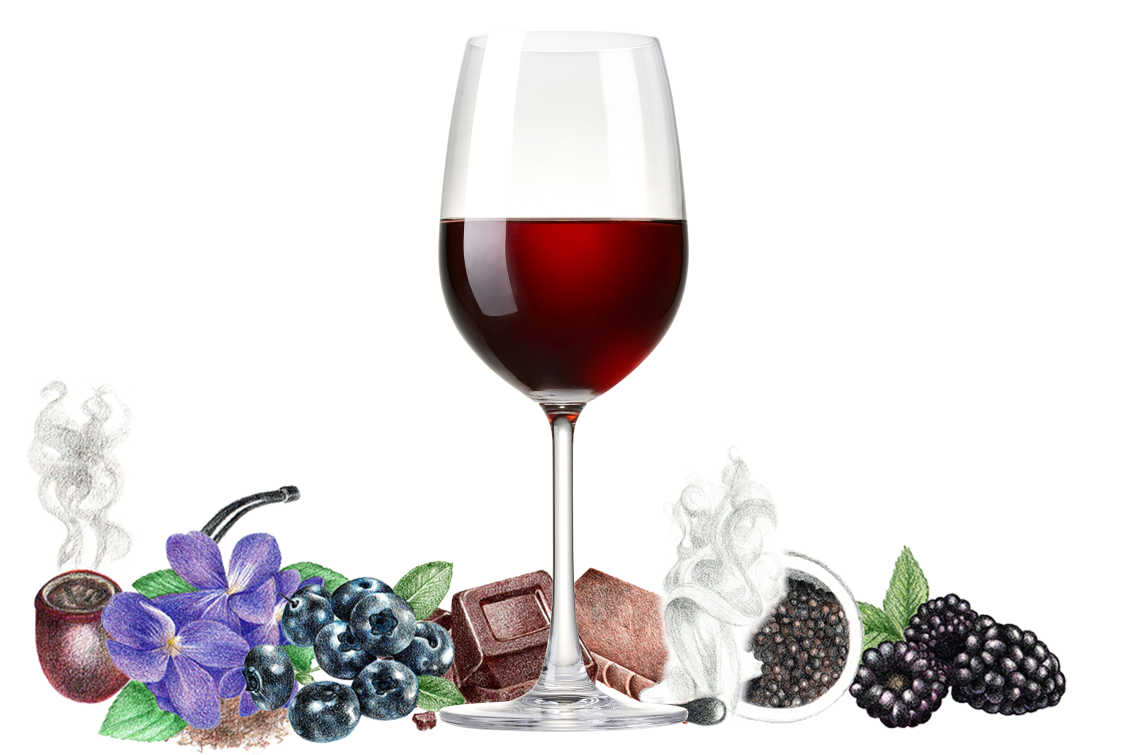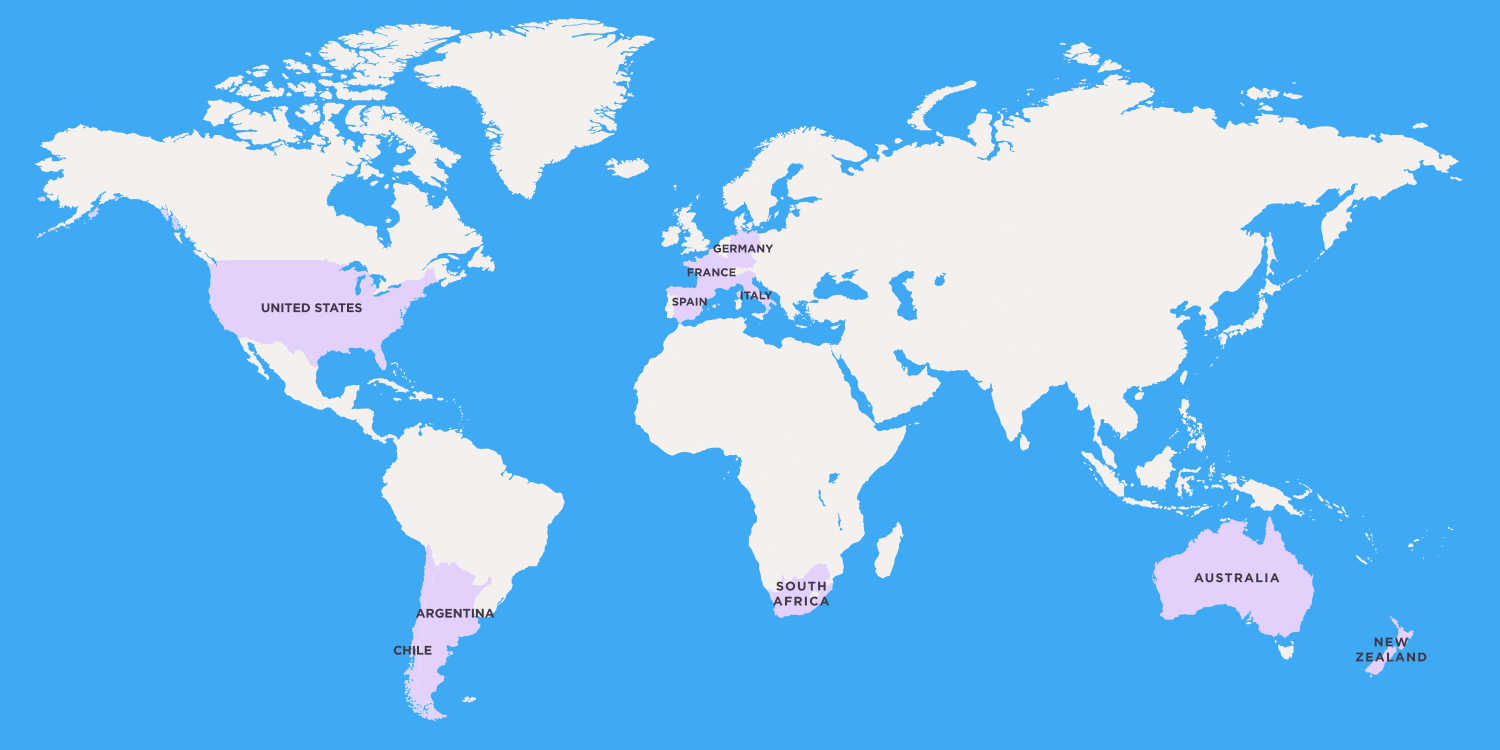Syrah
Syrah is a grape with a split personality. Syrah and Shiraz are just two names for the same grape.
Syrah is a grape with a split personality. Like Pinot Gris and Pinot Grigio, Syrah and Shiraz are just two names for the same grape. What's in a name? For Syrah, it can tell you a lot. A Rhône Valley Syrah is powerful and rich. Australian Shiraz is fruit-forward and punchy. Cool climate Syrah from Sonoma is yet another thing, all acidity and smokey, earthy flavors. The name a winemaker chooses to use when working with the Syrah grape will usually tease out their aspirations.
Syrah is originally from the northern end of the Rhône Valley, with the most famous examples coming from the Côte-Rôtie, or "Roasted Slope." Today great Syrah is grown all over the world, but many of the best New World examples still follow the Old World style.
Syrah is possibly the great unifier of the wine world, almost everyone loves it. Whether it comes from Australia or Southern France, or whether it is part of a "GSM" (Grenache, Syrah, Mourvèdre) blend it's fun and easy to enjoy for wine drinks at every level.

Take The Quiz
Learning about different wine varietals and regions is fun. Take the quiz now to explore wines matched to your unique palate.
Take The QuizIN THIS ARTICLE:
History of Syrah
Syrah (pronounced sih-rah) is the offspring of two mostly unheard-of grape varietals: the red wine grape Dureza and the white grape Mondeuse Blanche.
Until genetic testing confirmed this, there were some incredibly far-flung theories. Some said that it came from Persia, others believed it came from a crusader returning from the holy land, and still others said that it was from Egypt or Sicily. While these romances are nice to believe, the grape is actually local to the northern Rhône.
Over time the place that really made the grape famous was Hermitage, a location that is still famous for making powerful Syrahs. Even the Bordeaux loving, third American President, Thomas Jefferson, loved wines from Hermitage and had them brought to the United States.
In the 1700 and 1800s, Syrah from the Rhône Valley was used to help fortify Bordeaux wines by the many negociants making claret (wine from Bordeaux produced for export). Through this blending practice, the grape spread and worked its way south to Languedoc, where it continued to be used in blends.
Fun Fact
This grape is gown as far afield as Morocco, Tunisia, and Lebanon where it is used in blends at Chateau Musar.
An early immigrant to Australia, Syrah was one of the 400 varietals taken by James Busby to his new home. It was particularly well received in the southern parts of the country.
Fast forward to the 1950s and Max Schubert, the winemaker at Penfolds, had the idea to make Australian Syrah using practices he observed in Bordeaux. He used a blend of concentrated Syrah grapes, new oak, and a long maturation process. It was a runaway success and put Australian Syrah, and then Shiraz (the more fruit-forward style) on the map.
The brash Aussie Shiraz was en vogue during the 80s and 90s, but now we are starting to see the pendulum swing back and more producers are making vibrant cool-climate Syrah. New World winemakers like Pax Mahle do both, and he is quoted saying that Syrah is about the site and not the style you wish to make it in.
What does Syrah taste like?
What is the wine named? Is it Syrah or Shiraz? The name holds the key to how the wine will taste. But most Syrah wines of either type will feature notes of blueberry, blackberry, smoke, black pepper, licorice, and sometimes savory, earthy components like herbs, leather, chocolate, and tobacco. Cooler climates, in particular, will feature violets and other floral components.
Fun Fact
Confusingly there is another grape called Petite Sirah (Durif), this is an entirely different grape that is not related to Syrah.
Syrah Characteristics
The Syrah grape is thick-skinned, which can impart rich tannins to a wine. It has decent acidity as well as a medium to full-body depending on the climate. It is very choosy about the soils it grows in, but when it finds a good site it grows quickly. Difficult sites tend to make the best Syrah. Heavy use of new oak is a hallmark of the Shiraz style.
Despite the power in the grape, it does a good job showcasing terroir, and differences can be tasted across appellations. Northern Rhône Syrah, Côte-Rôtie, Hermitage, and Crozes-Hermitage all feature unique notes from the same grape.
It is a red grape variety that is perfect for blending and is most often seen in the famous "GSM" blend or with Viognier.
Syrah Nutritional Facts
The nutritional value in Syrah varies greatly depending on two main factors: alcohol and sugar.
The alcohol in Syrah varies depending on how ripe the grapes were when harvested, if the winemaker added extra sugar, and how long it was allowed to ferment. The more sugar present in a wine, the more carbohydrates. Syrah wines are generally in the middle range for all of these categories.
How to Serve and Store Syrah
The most tannic, well-oaked, and well-made wines from the best vintages can age for decades, but like most wines the majority of Syrah is meant to be enjoyed fresh and should not be aged.
Serving Syrah can be done simply. The wine should start slightly lower than room temperature, but it can be served with some warmth. Realistically this is all personal preference. Enjoy your wine how you like it.
To open you will need a traditional corkscrew.
If you are storing Syrah, it should be in a cool place that does not receive direct sunlight, and preferably in a wine refrigerator or cellar. 55 degrees Fahrenheit is the median temperature wine should be stored if you wish to age the bottles. What matters most is consistency. Do not store your Syrah in a place that receives direct sunlight, heat, or too much humidity and remember to enjoy it while it's fresh. Ultra-premium examples can age for a decade or more.
What to Pair with Syrah
Pairing wine has some general rules, but we think the most important rule is to drink Syrah with the food you like. Syrah is a good choice for rich foods. Some of the most interesting pairings involve wild game and barbecued red meats.
Syrah Wine Regions Around the World
Syrah is truly an international grape and grows all over the winemaking world. The styles vary greatly by region and by producer. Here is a brief overview of where it is growing, and broad tasting notes associated with each region.
France:
The Northern Rhône Valley is the home of this grape, and it is still in excellent form throughout the region. The Southern Rhône is generally too hot for the grape to make single-varietal wines, but in Châteauneuf-du-Pape and Côtes-du-Rhône blends, the Syrah adds structure and color.
Australia:
The best Australian examples of the grape come from Barossa Valley and the McLaren Vale. Barossa Shiraz is the Aussie Shiraz at its best: full of oak and ripe fruit from dry-farmed old vines. Barossa Shiraz is concentrated and powerful. Some winemakers there ferment the Shiraz with Viognier to developed its texture.
Aussies use Syrah for almost everything, some are even using it to make fortified wine or sparkling reds.
United States:
Syrah wasn't really made in the United States until the "Rhône Rangers" movement in the 1970s brought the Rhône varietal to California's Napa Valley and Paso Robles.
Today the best examples of California Syrah come from cool-climate vineyards like Carneros, Sonoma, and Santa Barbara. But Syrah in the United States isn't just limited to California, and we are increasingly seeing good examples come from Washington State and Oregon.
Syrah growing elsewhere:
Syrah is grown all over the world even if it isn't always the star of a region. In South Africa, many producers are pursuing Shiraz style wines. Chile is producing both Syrah and Shiraz styles in different regions. Other countries like Italy and Spain like to use it for blends. Mendoza, Argentina is known for making wines similar to the southern Rhône, and the warmest vineyards in New Zealand also make nice examples.

Take Our Quiz Today
Get award-winning delicious wines from all over the world shipped straight to your door. Take the quiz to get the perfect pairings for your holiday season.
Take The Quiz TodayIN THIS ARTICLE

WinePrint™ by Firstleaf
Are you looking to learn more about your wine preferences? Check out our Wine Print for an in-depth look at your personal tasting profile. Discover your favorite wines, varietals, regions, and tasting notes and get personalized recommendations wherever you are.
Learn More
